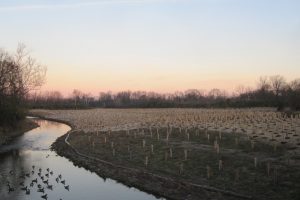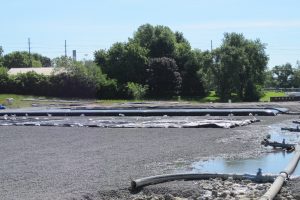Dicks Creek, Middletown, OH

KEMRON was awarded a fixed price contract to perform sediment removal via hydraulic dredging from Dicks Creek in Middletown, Ohio for a private manufacturing client. The scope of work included design of the dredge process, design and construction of a customized dredge platform, design and construction of a 8 acre Dredge Material Management Area (DMMA) to include a lined dewatering impoundment and high flow water treatment system. All work from design to fabrication of systems through construction and operation of the hydraulic dredge and water treatment plant was completed by KEMRON personnel. The dredge area encompassed two miles of receiving stream up to the confluence with the Miami River. Key components of the project include:
- Construction of a DMMA to include a dewatering bed and water treatment system
- Dredging of sediment from Dicks Creek
- Dewatering of sediment in GeoTubes and transport to landfill
- Replacement of removed sediment with clean sand Restoration of the staging area and stream bank
The project involved removing, by hydraulic dredging, sediment at prescribed depths throughout a 6,800 foot section of creek. Dicks Creek is a rather large creek which flows into the Greater Miami River in southern Ohio. Widths vary from 50 to 80 feet. KEMRON designed and constructed the DMMA, comprised of a dewatering zone, sediment storage area and water treatment areas along the banks of Dicks Creek. The dewatering zone was cleared, bermed and lined with geotextile fabric and a 40 mil HDPE liner. A sump was created to collect decanted water from the Geotubes and contact water from rainfall. KEMRON elected to increase quality, thickness and rigidity of the liner material over preliminary design considerations due to the intended use and the volume of water to be managed. The seams of the HDPE liner were welded rather than chemically sealed, providing a much more durable temporary work area. The dewatering zone was sloped to promote drainage to a sump used to collect and route water to the water treatment plant. Sediment recovered was pumped to geotubes located in the dewatering zone.
KEMRON designed a temporary wastewater treatment system to treat water from sediment dewatering and contact water in the staging area. The system was designed to a capacity of 2,000 gallons per minute (gpm). The treatment system included two standard fractionation tanks, each rated at 20,000 gallons capacity. The system provided temporary storage capacity of up to 40,000 gallons of water and was used to manage recirculation, back flushing and bulk storage needs during the dredging operations. Transfer pumps utilized in the system were capable of pumping in excess of 1,000 gpm (each) at pressures sufficient to pass the water through the filters, piping, GAC units, and to the final discharge point on Dicks Creek. Replacement pumps were on hand throughout the project in the event of malfunction for immediate switch-out.

Sediment removal was accomplished by placing a 6-inch hydraulically operated pump on a work platform barge. Crews used two 4-inch suction hoses with specially fabricated suction heads to vacuum the sediment from the creek bed. The sediment and sand was up to three feet in depth. The water and sand/sediment mix vacuumed from the floor of the creek was pumped through an 8-inch HDPE line placed along the creek. At times the depth of the creek required the dredge team to don diving gear in order to complete the area. The sediment mixture was pumped into GeoTube bags in a dewatering bed constructed in the staging area. Polymer was injected inline prior to the material entering the GeoTubes to facilitate dewatering. Water effluent from the bags were collected in a sump and pumped through bag filters and carbon vessels prior to discharge back into Dicks Creek. On average, more than 600,000 gallons of water were treated per day.
Once the dredge crew had progressed approximately 3000 feet downstream a sand/sediment restoration crew began replacing the removed sediment with clean sand. An additional 8 inch HDPE pipeline was placed along the stream adjacent to the access road to facilitate the restoration effort. A high pressure 6 inch trash pump forced 1000 gallons per minute of water through an inductor nozzle which had been fitted with a sand hopper and connected to the pipeline. As the water passed through the inductor sand was pulled into the water stream by the venturi effect created. The sand slurry was pumped through the pipeline and into a discharge hose fitted with a fabricated diffuser head.
The final phase of the project involved stream bank restoration and restoring the 8 acre DMMA area. The design called for creating a floodplain area and a riparian forest. After grading to the prescribed elevations over 4000 shrubs and trees were planted in this area.